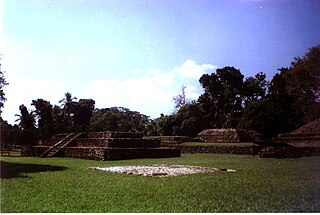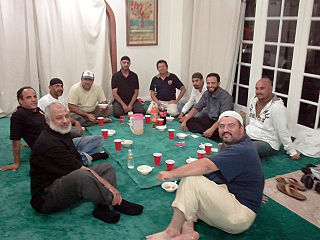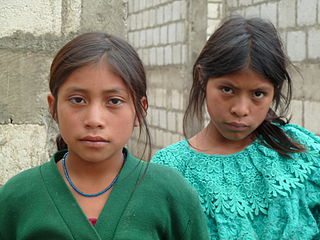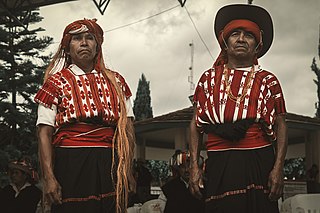
Chiapas, officially the Free and Sovereign State of Chiapas, is one of the states that make up the 32 federal entities of Mexico. It comprises 124 municipalities as of September 2017 and its capital and largest city is Tuxtla Gutiérrez. Other important population centers in Chiapas include Ocosingo, Tapachula, San Cristóbal de las Casas, Comitán, and Arriaga. Chiapas is the southernmost state in Mexico, and it borders the states of Oaxaca to the west, Veracruz to the northwest, and Tabasco to the north, and the Petén, Quiché, Huehuetenango, and San Marcos departments of Guatemala to the east and southeast. Chiapas has a significant coastline on the Pacific Ocean to the southwest.

The Mayan languages form a language family spoken in Mesoamerica, both in the south of Mexico and northern Central America. Mayan languages are spoken by at least six million Maya people, primarily in Guatemala, Mexico, Belize, El Salvador and Honduras. In 1996, Guatemala formally recognized 21 Mayan languages by name, and Mexico recognizes eight within its territory.

The Lacandon are one of the Maya peoples who live in the jungles of the Mexican state of Chiapas, near the southern border with Guatemala. Their homeland, the Lacandon Jungle, lies along the Mexican side of the Usumacinta River and its tributaries. The Lacandon are one of the most isolated and culturally conservative of Mexico's native peoples. Almost extinct in 1943, today their population has grown significantly, yet remains small, at approximately 650 speakers of the Lacandon language.

The Maya are an ethnolinguistic group of indigenous peoples of Mesoamerica. The ancient Maya civilization was formed by members of this group, and today's Maya are generally descended from people who lived within that historical region. Today they inhabit southern Mexico, Guatemala, Belize, and westernmost El Salvador and Honduras.

Mesoamerican languages are the languages indigenous to the Mesoamerican cultural area, which covers southern Mexico, all of Guatemala, Belize, El Salvador, and parts of Honduras, Nicaragua and Costa Rica. The area is characterized by extensive linguistic diversity containing several hundred different languages and seven major language families. Mesoamerica is also an area of high linguistic diffusion in that long-term interaction among speakers of different languages through several millennia has resulted in the convergence of certain linguistic traits across disparate language families. The Mesoamerican sprachbund is commonly referred to as the Mesoamerican Linguistic Area.
The Chʼol are an Indigenous people of Mexico, mainly in the northern Chiapas highlands in the state of Chiapas. As one of the Maya peoples, their indigenous language is from the Mayan language family, known also as Chʼol. According to the 2000 Census, there were 140,806 speakers of Chʼol in Chiapas, including 40,000 who were monolingual.

Izapa is a very large pre-Columbian archaeological site located in the Mexican state of Chiapas; it is best known for its occupation during the Late Formative period. The site is situated on the Izapa River, a tributary of the Suchiate River, near the base of the volcano Tacaná, the sixth tallest mountain in Mexico.

Tliltocatl vagans is a species of tarantula known commonly as the Mexican red rump. It ranges predominantly in Mexico, but is also found in Central America. They are terrestrial, burrowing spiders. The reason for the name red rump is because of its distinctive red hairs on its abdomen. Like most tarantulas, they will eat anything they can overpower, which is usually insects, but small lizards and rodents may also be consumed. They can grow up to a solid 6.5 inch leg span, with males typically being smaller and thinner than the females. They prefer shrubland habitats.

The Lacandon Jungle is an area of rainforest which stretches from Chiapas, Mexico, into Guatemala. The heart of this rainforest is located in the Montes Azules Biosphere Reserve in Chiapas near the border with Guatemala in the Montañas del Oriente region of the state. Although much of the jungle outside the reserve has been cleared, the Lacandon is still one of the largest montane rainforests in Mexico. It contains 1,500 tree species, 33% of all Mexican bird species, 25% of all Mexican animal species, 56% of all Mexican diurnal butterflies and 16% of all Mexico's fish species.

Comandanta Ramona was an officer of the Zapatista Army of National Liberation (EZLN), a revolutionary indigenous autonomist organization based in the southern Mexican state of Chiapas. She led the Zapatista Army into San Cristóbal de las Casas during the Zapatista uprising of 1994, and was the first Zapatista to appear publicly in Mexico City.

Huipil is the most common traditional garment worn by indigenous women from central Mexico to Central America.

Mexico has a religious minority of Muslims, mostly constituted by converts, and Mexicans of African, Asian, European, and South American origin, as well as their children, born in Mexico.

San Juan Chamula is a municipality and township in the Mexican state of Chiapas. It is situated some 2.9 km (1.8 mi) from San Cristóbal de las Casas. As of 2010, the municipality had a total population of 76,941. Virtually the entire population of the municipality is indigenous and speaks an indigenous language. In 2010, the census reported that 99.5% of the population age 3 years or older speaks an indigenous language. The Tzotzil people and language dominate the municipality.

The Mam are an indigenous Maya people in the western highlands of Guatemala and in south-western Mexico who speak the Mam language.
The music of the ancient Mayan courts is described throughout native and Spanish 16th-century texts and is depicted in the art of the Classic Period. The Maya played instruments such as trumpets, flutes, whistles, and drums, and used music to accompany funerals, celebrations, and other rituals. Although no written music has survived, archaeologists have excavated musical instruments and painted and carved depictions of the ancient Maya that show how music was a complex element of societal and religious structure. Most of the music itself disappeared after the dissolution of the Maya courts following the Spanish Conquest. Some Mayan music has prevailed, however, and has been fused with Spanish influences.

Neozapatismo or neozapatism is the political philosophy and practice devised and employed by the Zapatista Army of National Liberation, who have instituted governments in a number of communities in Chiapas, Mexico, since the beginning of the Chiapas conflict. According to its adherents, it is not an ideology: "Zapatismo is not a new political ideology or a rehash of old ideologies. .. There are no universal recipes, lines, strategies, tactics, laws, rules or slogans. There is only a desire: to build a better world, that is, a new world."

Palenque is a city and municipality in the Mexican state of Chiapas in southern Mexico. The city was named almost 200 years before the nearby Mayan ruins were discovered in the 18th century. The area has a significant indigenous population, mostly of the Ch'ol people, a Mayan descendant. The city is the only urban area in a municipality of over 600 communities, and is surrounded by rainforest. Deforestation has had dramatic effects on the local environment, with howler monkeys occasionally seen in the city as they seek food. While most of the municipality's population is economically marginalized, working in agriculture, the Palenque archeological site is one of the most important tourist attractions for the area and the state of Chiapas. It is the poorest major city in the state of Chiapas.

Vitis tiliifolia is a New World liana in the grape family commonly known as Caribbean grape. Other names include West Indian grape, water vine, Agrá and Bejuco de Agua and water tie-tie and water-wise.

Pozol is the name of both fermented corn dough and the cocoa drink made from it, which has its origins in Pre-Columbian Mesoamerica. The drink is consumed in the south of Mexico in the states of Campeche, Chiapas, and Tabasco. It is a thirst quencher that has also been used to fight diseases. It has also aided indigenous peoples of the Americas as sustenance on long trips across the jungles.

The Tzeltal are a Maya people of Mexico, who chiefly reside in the highlands of Chiapas. The Tzeltal language belongs to the Tzeltalan subgroup of Maya languages. Most Tzeltals live in communities in about twenty municipalities, under a Mexican system called “usos y costumbres” which seeks to respect traditional indigenous authority and politics. Women are often seen wearing traditional huipils and black skirts, but men generally do not wear traditional attire. Tzeltal religion syncretically integrates traits from Catholic and native belief systems. Shamanism and traditional medicine is still practiced. Many make a living through agriculture and/or handcrafts, mostly textiles; and many also work for wages to meet family needs.

















